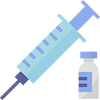You can catch a cold or flu any time of the year, but they seem as common as sweaters during the cooler months. While you can’t always avoid getting sick, you can take steps to lower your odds. Here are some of the best tips to avoid cold and flu all year long.
WASH YOUR HANDS

Cold and flu viruses are primarily transmitted through respiratory droplets expelled when an infected person coughs, sneezes, or talks. These viruses can also survive on surfaces for several hours, increasing the potential for indirect transmission through contaminated hands.
When people touch their face, mouth, or eyes with unwashed hands, these viruses can enter their bodies, causing them to get sick, even if they weren’t directly exposed to a sick person.
Handwashing is such a powerful tool against germs, that the CDC says it is one of the best ways to keep you and your family from getting sick. Wash regularly with soap and water for about 20 seconds — especially when handling food, caring for someone sick, or after using the restroom.
Hand sanitizers are a great tool to help keep your hands clean from germs but are not a replacement for regular handwashing. Using hand sanitizers in conjunction with handwashing is the best way to help keep your hands clean to avoid flu and cold germs.
AVOID TOUCHING YOUR FACE
As mentioned above, touching your eyes, mouth, or nose with unwashed hands is an excellent way to catch the flu or a cold. If you frequently touch your face, try to be more conscious of this behavior and only touch your face with freshly washed hands.
If you’re someone with a nail-biting habit, it’s time to try and quit. Cold, flu, and other germs can get stuck under your fingernails and aren’t as easily washed away as other areas of your hands. When you bite your nails, you might be exposing yourself to a whole slew of bacteria that might get you sick.
GET VACCINATED

The CDC recommends getting a yearly flu vaccine as the most important way to protect yourself from flu viruses. Ideally, everyone six months and older should get one — especially if you’re high-risk for flu complications.
WHAT TO DO WHEN YOU ARE ALREADY SICK

Even after you’ve come down with a cold or flu, you can take measures to manage your symptoms and feel better.
STAY HOME

Cold and flu bugs are contagious and easily passed through the air. That’s why anyone with flu symptoms should stay home (except for necessities) for at least 24 hours after the fever is gone.
When a person has a fever, it indicates the immune system is hard at work fighting sickness. People with fevers are more likely to transmit the virus to others, so by allowing enough time for a fever to break, individuals can ensure they are no longer contagious before resuming their normal activities, including work.
By staying home, individuals who are experiencing flu symptoms can minimize the risk of infecting others, particularly in a workplace setting where close contact with others is common.
WEAR A MASK
If you have to leave your home to run essential errands while you have a cold or flu, wear a mask to protect yourself and others. The U.S. Centers for Disease Control and Prevention (CDC) has established guidelines on the use of masks to help prevent the transmission and contraction of flu viruses.
According to the CDC, it is suggested anyone with flu or cold-like symptoms wear a medical-grade mask when around others.
These symptoms include:
- Cough
- Fever
- Difficulty breathing
- Stuffy or runny nose
- Sneezing
- Chills
- Vomiting
- Diarrhea
- Extreme tiredness
- Aching muscles or body
Masks not only help prevent the transmission of the cold and flu, but they also help prevent contraction. If you plan on being in a crowded space or a place in close proximity to others (like an airplane) during cold and flu season, consider wearing a medical-grade mask to help you avoid getting sick.
Remember, masks must be worn over the nose and mouth and have a secure fit. Try and replace your mask every 24 hours or whenever it is visibly dirty to help make it the most effective for cold and flu prevention.
OTHER REMEDIES TO TRY AT HOME
When you’re already battling the discomfort of cold and flu symptoms, incorporating simple yet effective remedies at home can significantly contribute to a speedier recovery. Staying well-hydrated is key to supporting your body's immune system and helping to ease congestion. Warm fluids like herbal teas, broths, and soups can provide comfort and much-needed hydration.
Additionally, avoiding alcohol and caffeine is crucial during illness, as they can lead to dehydration and may interfere with quality rest. Opting for soothing beverages like ginger tea or honey-infused warm water can offer relief for sore throats and assist in overall recovery. These at-home remedies complement the efficacy of Mucinex® products, working together to help you feel better so you can get back to your normal routine.
HOW TO PREVENT COLD AND FLU FAQS
How can I prevent catching a cold or flu?
To prevent catching a cold or flu, it is important to practice good hygiene habits such as washing your hands regularly with soap and water, avoiding close contact with sick individuals, avoiding touching your face, and getting regularly vaccinated if you are able.
Should I wear a mask to help prevent catching a cold or the flu?
Wearing a mask can be beneficial in certain situations, such as when you are in close contact with someone who is sick or when you are experiencing symptoms yourself. However, masks are most effective when used in combination with other hygiene practices.
Can cold weather or going outside with wet hair increase my chances of catching a cold or flu?
Contrary to popular belief, being exposed to cold weather or going outside with wet hair doesn’t directly cause colds or flu. These viral infections spread through close contact with infected individuals or contaminated surfaces.
Should I stay home from work or school if I have a cold or flu?
Generally, it’s recommended to stay home from work or school if you have a cold or flu to prevent spreading the infection to others. Resting at home also allows your body to recover. Follow the guidelines of your workplace or educational institution regarding sick leave policies.
- Center for Disease Control and Prevention, 2022, Keeping Hands Clean
- Center for Disease Control and Prevention, 2019, Interim Guidance for the Use of Masks to Control Seasonal Influenza Virus Transmission
- Mayo Clinic (2022), Cold Remedies: What works, what doesn’t, what can’t hurt








